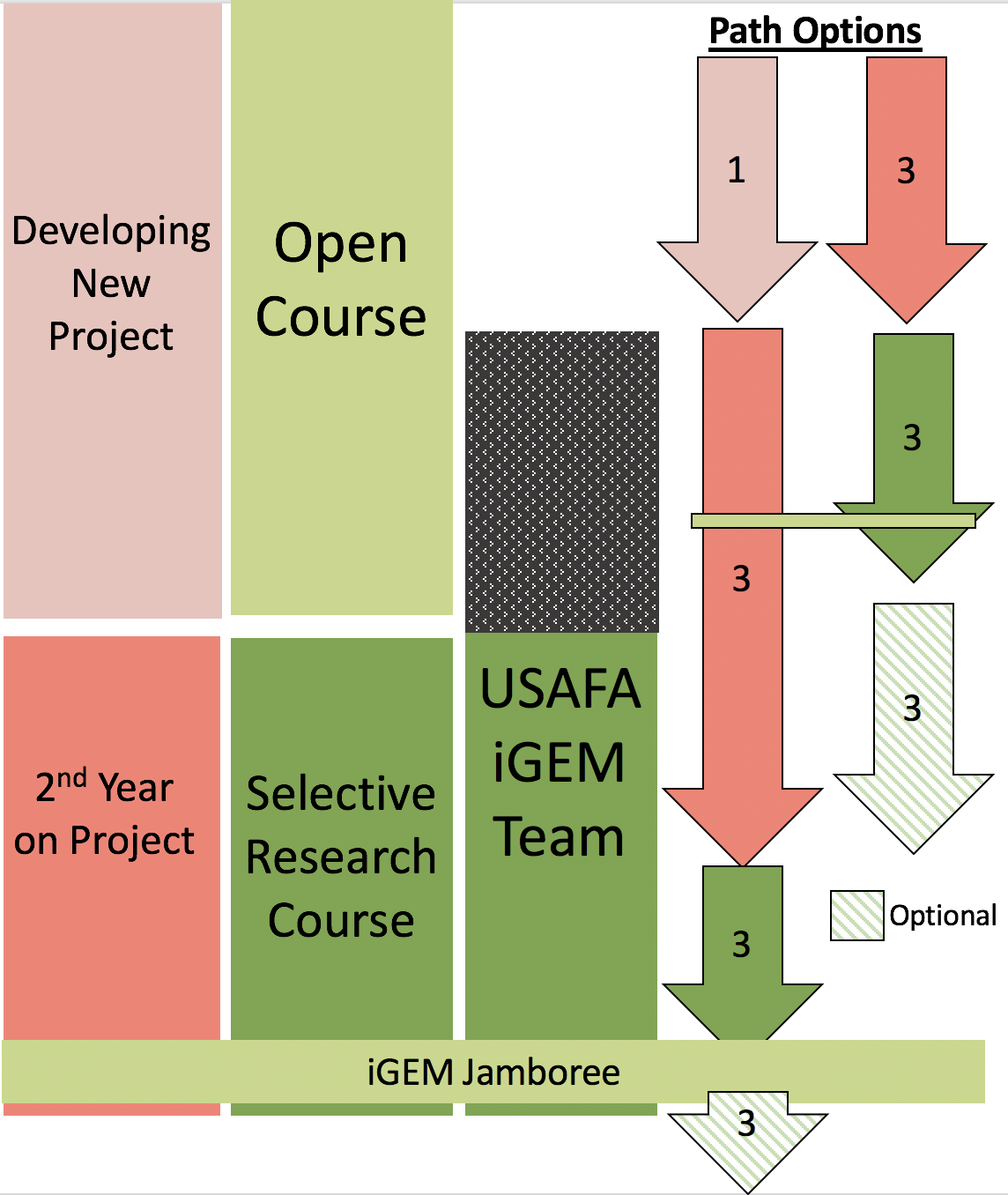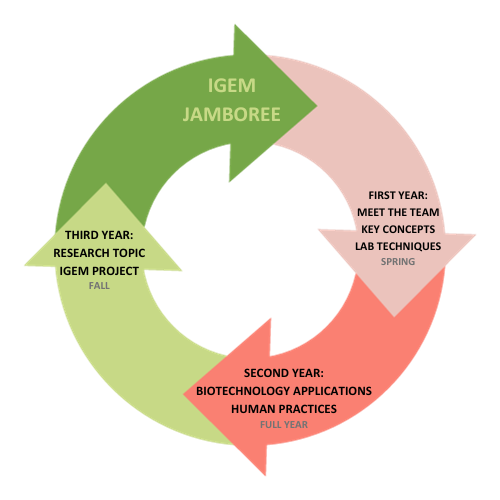The USAFA iGEM team has a longstanding tradition of placing significant emphasis on meaningful contributions to both the broader iGEM Community and the iGEM teams of tomorrow. This has been a source of genuine pride for us to uphold and build upon our legacy. We approach our role in the iGEM Community with a sense of camaraderie and collaboration, understanding the value of mentorship and support in nurturing the next generation of scientific innovators. By offering our experience and resources, we hope to ensure that iGEM continues to thrive, fostering a community that values excellence, creativity, and the relentless pursuit of scientific discovery.
Part Registry: We added 6 new parts to the registry
- Salp12 BBa_K4578000
- OspA BBa_K4578001
- INP-OspA BBa_K4578003
- Salp12 expression block BBa_K4578005
- OspA expression block BBa_K4578006
- INP-OspA expression block BBa_K4578008
More information about new parts can be viewed in the Engineering page! Engineering Success
Model Organism to study Lyme diagnosis in BSL1
In the pursuit of our Lyme disease research project, we encountered a need for innovative biological tools. Our project aims to utilize the remarkable properties of Salp12 in attracting Borrelia burgdorferi while detecting key biomarkers, specifically OspA and OspC, using E. coli as a model organism. To achieve this, we had to engineer a series of BioBricks to assemble these parts effectively. Notably, the OspA and OspC sequences are complex and challenging to synthesize directly. To address this, we divided these sequences into BioBricks, simplifying their assembly for future research endeavors. Our commitment to facilitating advancements in Lyme disease research led us to create a curated collection of 18 protein parts (BBa_K4578000-BBa_K4578017). These parts enable straightforward assembly and well-documented production of Salp12 and the targeted Lyme disease biomarkers. Our project endeavors to contribute to the fight against this debilitating disease by expanding the utility of BioBricks in novel ways. With this collection we hope to aid future teams in developing innovative projects of benefit to the world.
View more about how these new parts were applied to our project in the Engineer Success page! Engineering Success
Tools to recruit a successful iGEM team
Here are some of the ways in which the USAFA iGEM Team has changed recruitment to get off on the right foot each year.
Diverse Skill Sets: Our team members come from diverse backgrounds (5 majors) and bring a wide range of skills and experiences to the team, enriching our multidisciplinary approach to iGEM projects.
Outreach and Education: We conduct workshops and informational sessions to educate potential team members about synthetic biology and iGEM, fostering interest and demonstrating the relevance of iGEM participation.
Recruitment Events: We host recruitment events to showcase past iGEM projects, introduce potential recruits to current team members, and provide insights into the iGEM experience.
Tips to increase your iGEM team’s Diversity and Inclusion efforts
Promoting inclusivity in the iGEM community is crucial for fostering a diverse and equitable environment, while recruiting for and prolonging the program–so it is our team’s first priority. These steps can serve as foundational principles for promoting inclusivity and diversity beyond the lab, contributing to a more inclusive and welcoming environment for everyone.
Offsite Retreats: Within the first few weeks as a new team, the USAFA iGEM students took a trip to a retreat center to not only work on potential projects and understand synthetic biology, but get to know the group and become unified in team building exercises and activities. The team also spent time going to dinner after late nights in the lab and playing sports together to further build our teamwork skills. Other teams can consider building team bonding events into their schedules to foster an environment that bolsters unit cohesion.


Monthly Trainings: USAFA iGEM students have a unique opportunity to receive monthly trainings on diversity and inclusion, sexual assault and harassment, as well as mental health. The addition of these events has created an environment of zero-tolerance and trust among students and faculty. Incorporating this into an iGEM team’s regiment can greatly change the communication and relationships among a team. Other teams should consider training their members in these topics to foster an environment of acceptance.
Honor Code: Finally, our team abides by an honor code at our school. This states, “We will not lie, steal, or cheat, nor tolerate among us anyone who does.” If a team’s school does not have an honor code, we believe this is crucial to create among a team in order to promote clear expectations and ensure accountability within the team and iGEM organization as a whole. Other teams should consider implementing an honor code of their own to instill an environment of trust in their team.

Create a course to help your iGEM team succeed


The USAFA iGEM Team is dedicated to creating a hard-working and disciplined team. Some ways that we have accomplished this are through dedicated research classes, providing a structured environment for team members to engage in iGEM projects effectively. This has also changed how time constraints from faculty can be changed to dedicate and provide valuable mentorship and guidance to iGEM team members, enhancing our recruiting and mentoring efforts.
Our new approach, the “Three Year Plan,” promotes a new idea of learning about iGEM before committing to the team. This course sequence is designed to provide students with in-depth knowledge and practical experience in the field of Synthetic Biology and Biotechnology. It is open to sophomores and juniors, and successful completion of all courses can lead to a deeper understanding of these cutting-edge disciplines. Seniors will then be able to compete in iGEM competitions.
In a student’s first year, they will learn an introduction to key concepts and principles in synthetic biology and biotechnology. There will be a big emphasis on foundational theories and techniques while later exploring advanced topics in synthetic biology and biotechnology and beginning hands-on lab experience and case studies.
In their second year on the team, students dive deeper into advanced biotechnology applications, including gene editing, genome sequencing, and genetic engineering. They will learn from industry experts and begin to understand how the iGEM community interacts with people for human practices.
Finally, students who are interested will pursue a research topic of their choosing and work with the team to create a future iGEM project.
Overall, this 3-year course plan is invaluable for iGEM teams as it offers a structured curriculum covering synthetic biology and biotechnology, equipping students with comprehensive knowledge and hands-on experience necessary for success in iGEM competitions. Other iGEM teams should consider implementing a developed plan similar in order to not only improve ability to compete, but also enhance their students overall learning experience for a well rounded team.
References
Murfin, K. E., Kleinbard, R., Aydin, M., Salazar, S. A., & Fikrig, E. (2019). Borrelia burgdorferi chemotaxis toward tick protein Salp12 contributes to acquisition. Ticks and Tick-Borne Diseases, 10(5), 1124–1134. outer surfce protein A (plasmid) [Borreliella burgdorferi Bol26] - Protein - NCBI. (n.d.). Www.ncbi.nlm.nih.gov. Retrieved September 30, 2023
Borrelia burgdorferi strain IA outer surface protein C (OspC) gene, complete cds. (2002). NCBI Nucleotide.
Tabb, J. S., Rapoport, E., Han, I., Lombardi, J., & Green, O. (2022). An antigen-targeting assay for Lyme disease: Combining aptamers and SERS to detect the OspA protein. Nanomedicine: Nanotechnology, Biology and Medicine, 41, 102528.
Chávez, J. L., Hagen, J. A., & Kelley-Loughnane, N. (2017). Fast and Selective Plasmonic Serotonin Detection with Aptamer-Gold Nanoparticle Conjugates. Sensors (Basel, Switzerland), 17(4), 681.
Download Our Clip Art Here
Below are some of the pictures used for our website and project on Lyme Disease including ticks, band aids, gears, and more graphics. Please download and use at your own discretion.



